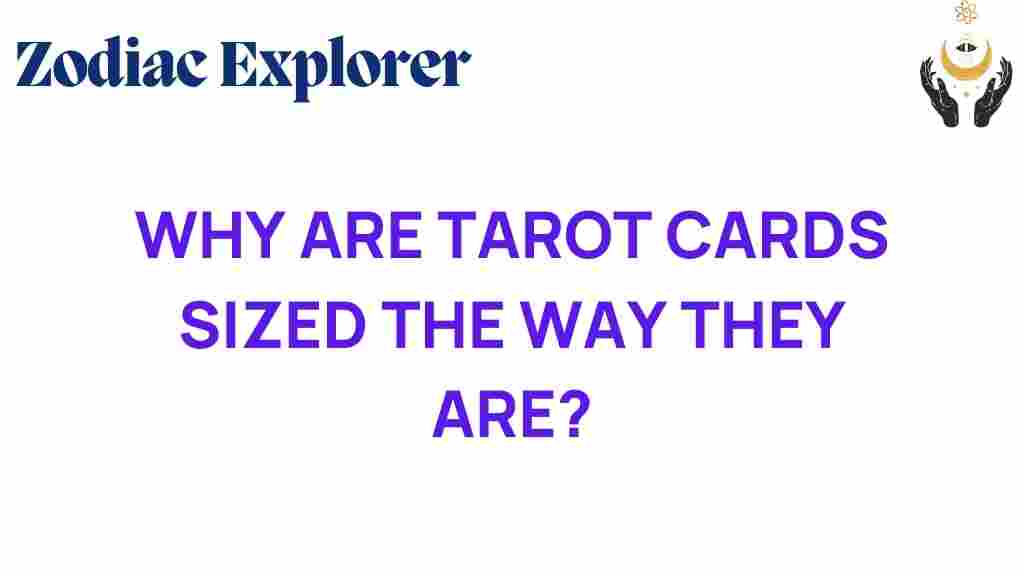The Surprising Reasons Behind Tarot Card Sizes
Tarot cards have long been associated with mysticism, divination, and personal insight. While many enthusiasts are familiar with the symbolism and history of tarot decks, fewer consider the significance of tarot card sizes. The dimensions of these cards can greatly influence reading experiences and interpretations. In this article, we will explore the various factors that contribute to the different tarot card sizes, from design choices to reader preferences, and how these elements shape the use of tarot as a divination tool.
Understanding Tarot Card Sizes
When we discuss tarot card sizes, we refer to the physical dimensions of the cards within a tarot deck. Typically, tarot cards come in a few standard sizes, but variations exist. The most common tarot card dimensions include:
- Standard Size: Approximately 2.75 x 4.75 inches (70 x 120 mm)
- Mini Size: Approximately 1.75 x 3.25 inches (45 x 85 mm)
- Large Size: Approximately 3 x 5 inches (76 x 127 mm)
- Oracle Card Size: Varies widely, but often larger than standard tarot cards
The Impact of Size on Readings
The size of tarot cards can significantly affect the reading experience. Larger cards might be easier to handle visually but could be cumbersome for shuffling, while smaller cards may be easier to manage but less detailed. Here are some factors to consider:
- Visual Clarity: Larger cards allow for intricate designs and clearer symbolism, enhancing the reading experience.
- Portability: Smaller decks are more convenient to carry around, which is ideal for on-the-go readings.
- Shuffling Ease: The dimensions of the cards can influence how easily a reader can shuffle and manipulate the deck.
The History of Tarot Decks and Their Sizes
The history of tarot decks is rich and complex, stretching back to the 15th century when cards were used for games and later adapted for divination. The original tarot decks were handmade, leading to variations in size and design. Over time, as tarot evolved into a tool for mysticism and self-discovery, standardized sizes began to emerge.
Historically, the most recognized tarot deck, the Rider-Waite-Smith deck, was created in 1909 and established a template for many modern decks. This deck’s dimensions have influenced countless other designs, solidifying the standard size of tarot cards as we know them today.
Symbolism in Tarot Card Sizes
Beyond mere functionality, the size of tarot cards can also hold symbolic meaning. Here are a few interpretations:
- Large Cards: Often symbolize the larger forces at play in one’s life or the need for broader perspectives.
- Small Cards: Can represent attention to detail, introspection, and personal insight.
Design Choices Influencing Tarot Card Sizes
The design of tarot decks is a crucial factor in determining their sizes. Artists and designers often choose dimensions based on the following:
- Artwork Detail: Larger cards allow for more intricate designs, which can enhance the card’s symbolism and the reader’s connection to the imagery.
- Reader Preferences: Some artists cater to the preferences of their target audience, whether they prefer larger or smaller cards.
Reader Preferences and Tarot Card Sizes
Reader preferences can vary widely, and understanding these can help both creators and users choose the right deck. Some readers may prefer:
- Standard Size: This size is versatile for most readers and is often the most widely available.
- Mini Decks: Ideal for those who travel frequently or desire a discreet deck.
- Large Decks: Often favored by readers who prioritize visual aesthetics and detailed imagery.
Choosing the Right Size for You
When selecting a tarot deck, consider the following steps:
- Evaluate Your Needs: Determine whether you will be reading for yourself, others, or both.
- Consider Portability: If you travel often, smaller decks may suit your lifestyle better.
- Test Different Sizes: If possible, handle various sizes to see which feels more comfortable in your hands.
Common Challenges with Tarot Card Sizes
Readers may encounter challenges related to tarot card sizes. Here are some troubleshooting tips:
- Difficulty Shuffling: If larger cards are difficult to shuffle, consider practicing different shuffling techniques or using a smaller-sized deck.
- Misinterpretation of Symbols: Smaller cards may lack detail, leading to misinterpretations. Ensure you familiarize yourself with the symbolism before reading.
Conclusion
In conclusion, the tarot card sizes play a crucial role in the overall experience of tarot reading. From historical influences to design choices and reader preferences, various factors contribute to the choice of card dimensions. Understanding these aspects can enhance your connection with your tarot deck and improve your readings.
As you explore the world of tarot and its divination tools, remember that the right size for your tarot deck is a personal choice that can influence your journey into the realm of mysticism. Whether you prefer the standard size or an oversized deck, the magic of tarot lies in the cards themselves and the meanings they hold for you.
For further reading on tarot and its mystical history, visit Tarot History.
If you’re interested in exploring different tarot decks, check out Deck Options for a curated selection of sizes and styles.
This article is in the category Myths and created by ZodiacExplorer Team
